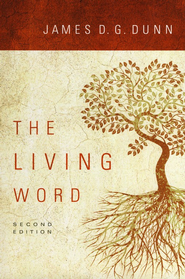| January 20, 2011 |
no comments
 James D.G. Dunn, The Living Word, second edition (Minneapolis, MN: Fortress, 2009), 224 pages, ISBN 9780800663551.
James D.G. Dunn, The Living Word, second edition (Minneapolis, MN: Fortress, 2009), 224 pages, ISBN 9780800663551.
James Dunn, professor of Divinity at the University of Durham and noteworthy New Testament scholar, advances the conversation between fundamental and liberal viewpoints on the authority, infallibility, and the inspiration of the Bible. As a second edition, Dunn modifies the twenty-year-old first edition to reflect the ongoing developments in this particular theological discussion. If the final chapter is read first, then the reader will quickly grasp the structure of the whole book, in order to understand his seven-fold thesis; the Bible is a “living tradition” (182). Dunn writes evenhandedly, delineating both sides of the dialogue through clear descriptions of the elements essential to both sides of the conversation. In this regard he draws attention to the “slippery slope” that both the fundamental and the liberal scholar risk when pressing their respective and opposing extremes.
The Bible is a “living tradition.”
Dunn’s thesis in the
Living Word claims that a “fundamentalist, whether a scripture fundamentalist or a tradition fundamentalist, has locked the word of God into human words or praxis, and is in effect worshipping an idol” (183). In doing this he labors to construct his foundation with scripture-formation stones and with the multivalent processes of oral tradition, redaction, collection, and canonization. His primary examples include the scripture-formation works of Ezra, the collections of Psalms, and the eclectic nature of the Proverbs. Canonization, Dunn states, recognizes the pre-canonization “authority that these texts were
already exercising” (Dunn’s emphasis, 184). Likewise, he states that the gospels are a “passed down, added to, subtracted from, reminted, and redacted, yet still authoritative tradition” (64). Thus he reiterates that scripture became scripture through the processes of recording oral tradition in writing, re-working the writings into standardized texts, receiving acceptance as the texts for canonical inclusion. Dunn used examples from both Jesus and Paul, demonstrating how they drew from multiple translations of the Old Testament, took liberty in their contextual exegesis with their selected texts, and thus brought new meaning from the old. Therefore, he posits, scripture has always been a “living” document that was and is being modified by the church. Multiplied ancient and contemporary translations illustrate this dynamic, supporting Dunn’s thesis.
“We can give the Bible too much honor; we can exalt the letter above the Spirit.”
— James D. G. Dunn
Two items of interest come to the surface as we reflect on the overall content of this book. First, we notice the seemingly ubiquitous influence of postmodern thinking that continues to undermine the truth-claims of modernity. Dunn posits that modernity and/or fundamentalism is “desperate for certainty” (161). It is as if to say that Jesus is like the postmodern exegete who opines “you have heard it said [insert OT saying] but I say [insert NT saying].” In this regard, he concludes, “Jesus was thereby abrogating part of the Mosaic law” (90). Further, that Jesus denied the “continuing authority of particular Mosaic ruling” (91). Thus, in like manner, he posits that as fundamentalism strives for certainty in the text, it is thereby sacrificing faith in the process. Fundamentalism is thus essentially Pharisaical in its dogma of scripture.
Second, Dunn subtly suggests that in regard to scripture, an unwavering defense of the term “inerrancy” erodes its credibility, perhaps even decreasing the potential influence of evangelical fundamentalism. This is seen as hand in hand with the truth-claims of modernity, thereby clearly recognizing the terminology of “inerrancy” as a consequence of modernity. He hypothesizes, “while New Testament passages that teach or imply a doctrine of scripture certainly affirm its inspiration and authority, it cannot be shown with any probability that the intention of their authors was to teach inerrancy” (100). It is in this subtle (or sometimes less-than subtle) manner that Dunn suggests the Spirit-filled nature of the Bible—when seen as the Living Word—leans towards both the postmodern and pneumatological exegesis of the Bible. In sum, “We can give the Bible too much honor; we can exalt the letter above the Spirit” (106).
Tags: dunn, james, living, word
Category: Biblical Studies, Pneuma Review, Winter 2011
 James D.G. Dunn, The Living Word, second edition (Minneapolis, MN: Fortress, 2009), 224 pages, ISBN 9780800663551.
James D.G. Dunn, The Living Word, second edition (Minneapolis, MN: Fortress, 2009), 224 pages, ISBN 9780800663551.

